North America Prefabricated Housing Market Size
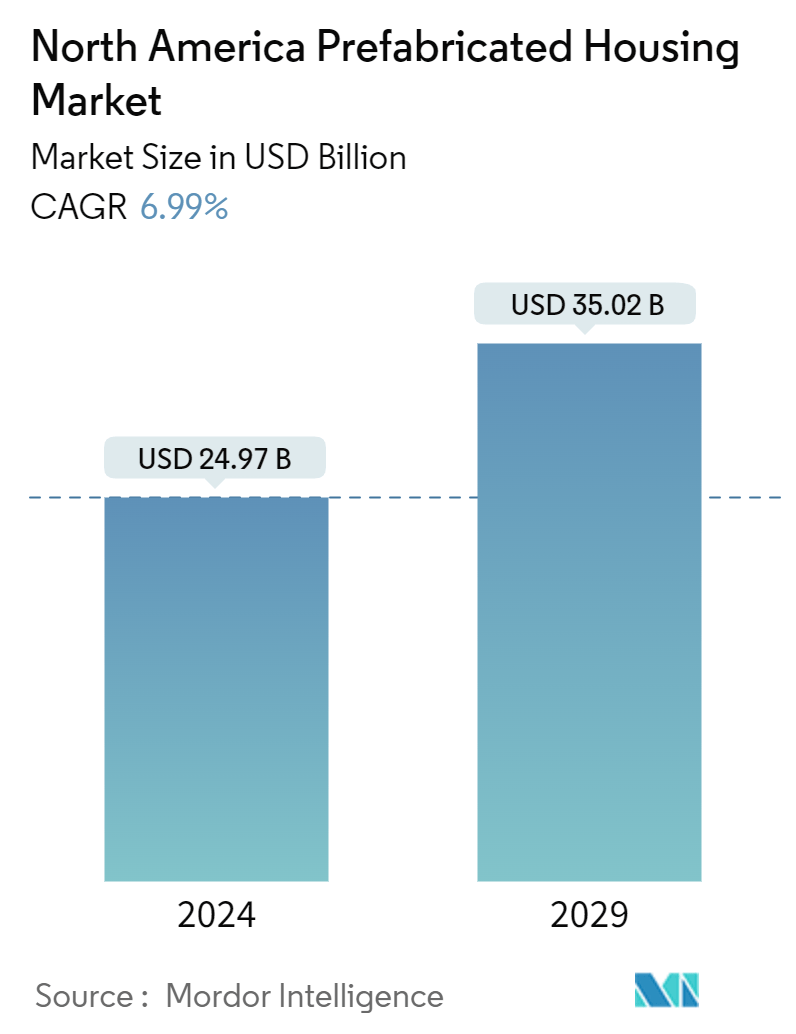
| Study Period | 2020 - 2029 |
| Base Year For Estimation | 2023 |
| Market Size (2024) | USD 24.97 Billion |
| Market Size (2029) | USD 35.02 Billion |
| CAGR (2024 - 2029) | 6.99 % |
| Market Concentration | Low |
Major Players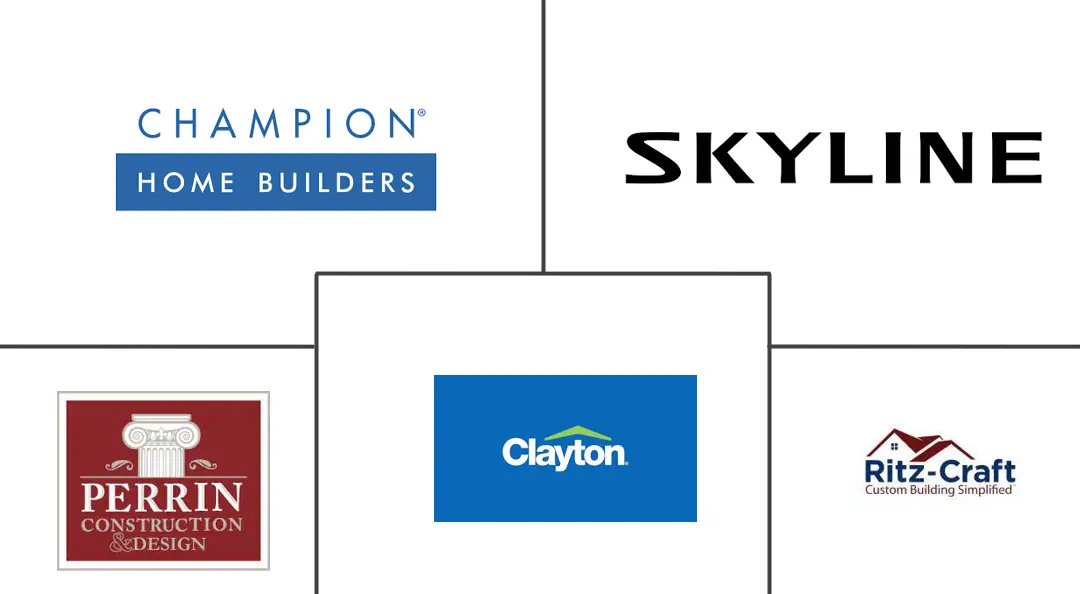
*Disclaimer: Major Players sorted in no particular order |
North America Prefabricated Housing Market Analysis
The North America Prefabricated Housing Market size is estimated at USD 24.97 billion in 2024, and is expected to reach USD 35.02 billion by 2029, growing at a CAGR of 6.99% during the forecast period (2024-2029).
The North America Prefabricated Housing Market size is estimated at USD 12.55 billion in 2024, and is expected to reach USD 13.47 billion by 2029, growing at a CAGR of 1.42% during the forecast period (2024-2029).
- Due to COVID-19 restrictions and lockdowns, many construction projects were delayed or canceled, and many construction companies shut down their projects. During the pandemic, the best solution was to use prefabricated buildings instead of traditional construction, which requires a lot of people. COVID-19 also had an effect on the market because it slowed down the production of raw materials, messed up the supply chain, slowed down trade, caused construction demand to drop, and made people less interested in starting new projects. But the number of COVID-19 cases and the need for buildings and units for healthcare and quarantine made more people want modular buildings.
- Most of the work in the North American construction industry is in reorganizing and remodeling, which require quick "turnkey" solutions. The region is a hub for small to large-scale modular service providers. The introduction of numerous government initiatives for promoting the construction of green buildings across the United States is also catalyzing the market. Moreover, the high prevalence of extreme cold weather in the region, leading to shorter days and heavy snowfall that inhibit on-site construction methods, is also propelling the need for modular construction. Nonresidential prefabricated building system demand in the US is expected to increase during the forecast period. The recovery in office and commercial construction, coupled with continued gains in institutional, industrial, and agricultural construction, will provide opportunities.
- The market for prefabricated homes has a lot of potential, especially in North America, where more and more people are looking for affordable, high-quality homes. Prefabricated buildings provide homeownership at a lower cost than houses built on-site, which is driving the market's growth. A prefabricated house makes it easy to use different interior and exterior architectural styles that can't be used in a house built on-site. During the forecast period, the North American prefabricated housing market could grow even more if technology keeps getting better and companies focus on giving customers good service.
- There is a shortage of affordable housing in the United States. Due to the high cost and long time required to build on-site houses and more young consumers wanting to own their own houses, this problem is expected to continue to exist. The shortage of on-site-built houses will provide market opportunities for prefabricated house manufacturers to build affordable single-family houses at a lower cost and in less time while providing convenience facilities, such as large kitchens and multiple bathrooms.
North America Prefabricated Housing Market Trends
Increase in Prefabricated Housing Market in North America
In North America, the productivity of several construction projects slowed down due to a labor shortage. Hence, companies are expected to utilize prefabricated construction to complete the projects faster. The use of additive manufacturing made using energy-absorbing materials, such as micro homes, is likely to bolster industry growth in the region.
Also driving growth are the rapid growth of cities in areas of the region that are just starting to develop and the growing investments in the construction sector.People are becoming more interested in ready-made solutions for prefabricated houses that meet their needs, so the market is expected to grow at a moderate rate.Prefabricated houses are likely to become more popular because people like the way they are made, the approval process, how long they last, and how cheap they are.
Using eco-friendly materials to make high-quality prefab homes is likely to have a positive effect on the market.
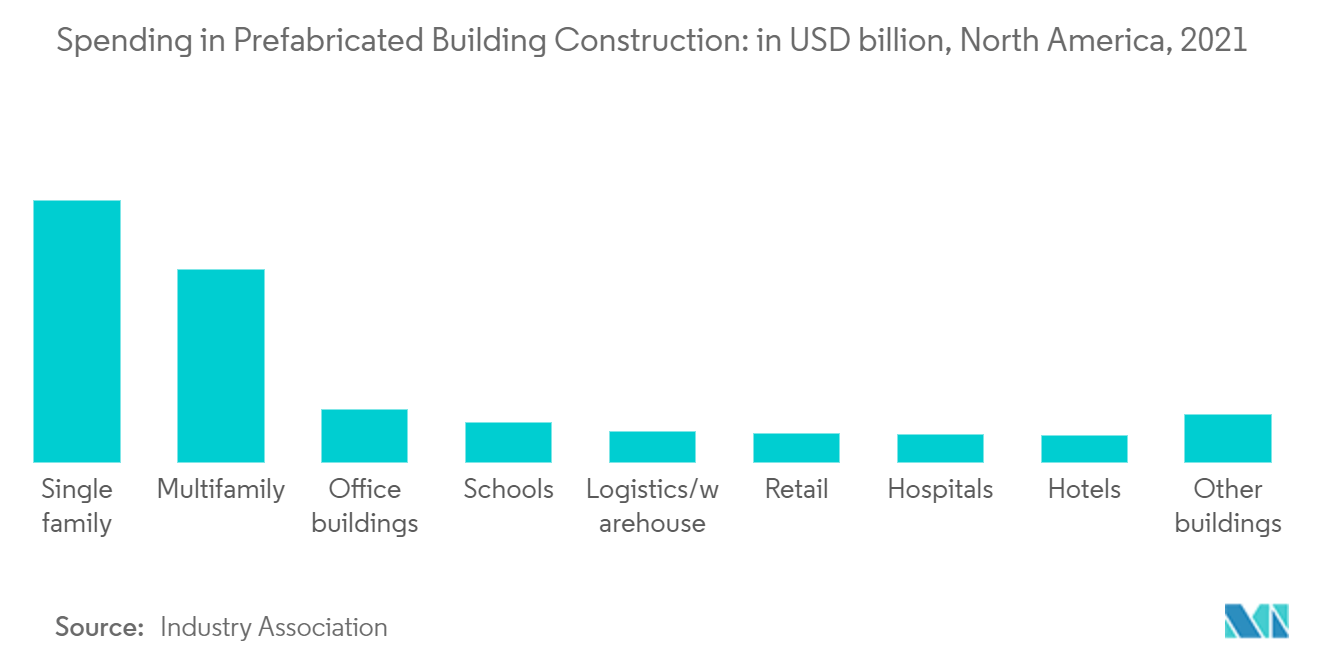
Rising Disposable income and Rising Demand from Residential Construction to Drive the Growth of the Industry
Estimates from the Bureau of Economic Analysis show that personal income rose by USD 1,954.7 billion (10%) in January 2021. DPI went up by USD 1,963.2 billion (11.4%), and PCE went up by USD 340.9 billion (2.4%). Personal outlays increased by USD 348.7 billion in January. Personal savings reached USD 3.93 trillion in January, and the personal saving rate, as well as personal savings as a percentage of disposable personal income, was 20.5%.
Also, research shows that as the country's economy recovers from the COVID-19 pandemic, the construction industry as a whole is beginning to recover, with the residential sector leading the way. There could be a clear rise in market activity in key cities like Los Angeles, San Francisco, Dallas, and Miami. As long as there is a lot of pent-up demand and mortgage rates stay low, the residential sector will lead the way. As the population grows, the healthcare and education sectors will also grow to meet the needs of more people.
Even though there hasn't been much change in the number of construction jobs, states like Georgia, Colorado, and Texas have seen impressive population growth, even during the pandemic. According to some reports, almost 85% of this growth is due to lifestyle choices. As long as most people continue to work from home, the commercial and retail markets will have to keep changing to meet the needs of those markets. In the last six months, there has been a lot of activity at critical facilities and data centers. This is because the need for data, storage, and infrastructure keeps growing.
According to the US Census Bureau and the U.S. Department of Housing and Urban Development, there were a total of 1,682,000 privately owned housing units that were given building permits in February. This number is based on a seasonal adjustment. which was 10.8% below the revised January rate of 1,886,000 but was 17.0% above the February 2020 rate of 1,438,000. Single-family authorizations in February were at a rate of 1,143,000; this was 10.0% below the revised January figure of 1,270,000. Authorizations of units in buildings with five units or more were at a rate of 495,000 in February. Over the next few years, the prefabricated building industry will be driven by the rising demand for new homes and the rise in disposable income and personal income in the country.
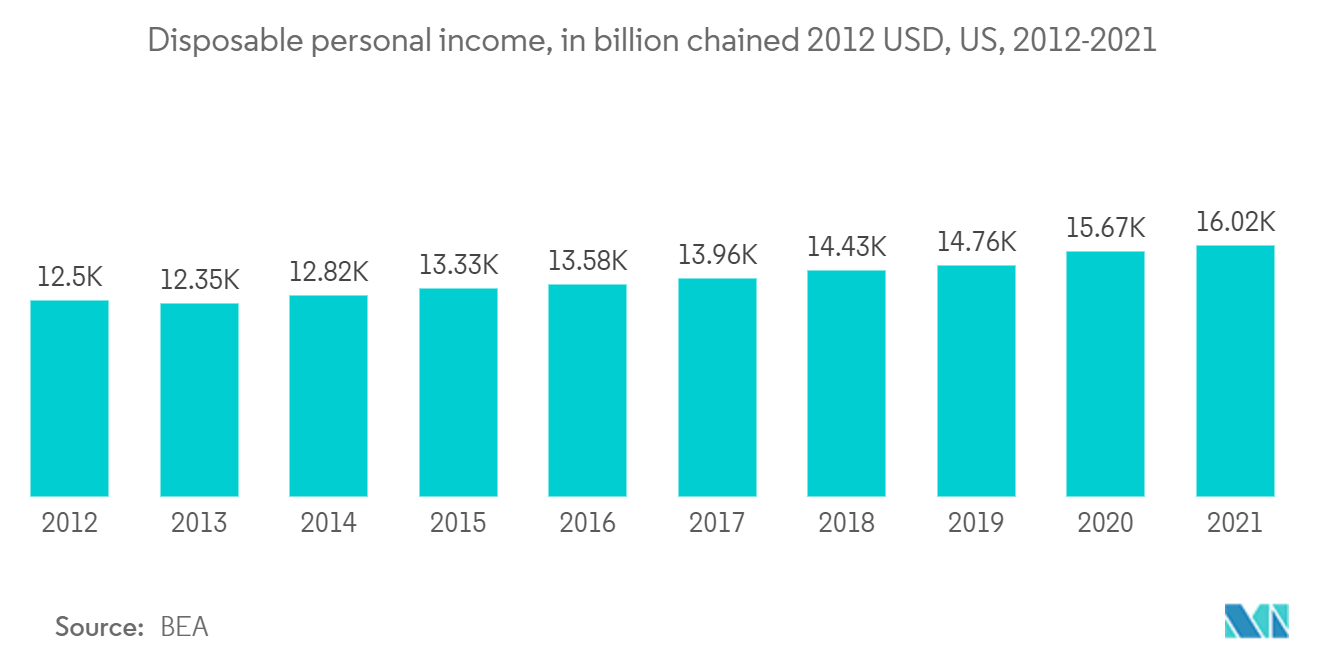
North America Prefabricated Housing Industry Overview
The market for prefabricated homes in North America is very fragmented, and no one has enough of the market to have a big impact. The market has a large number of prefabricated housing manufacturers and service providers. During the forecast period, the market presents opportunities for company growth, which is expected to drive market competition even further. The market is expected to grow during the forecast period due to increased prefabricated housing construction investments, upcoming major projects in the country, and other factors. Major players are Skyline Corporation, Champion Home Builders Inc., Clayton Homes Inc., Perrin Construction Co. Inc., and Ritz-Craft Corporation.
North America Prefabricated Housing Market Leaders
-
Skyline Corporation
-
Champion Home Builders Inc.
-
Clayton Homes Inc.
-
Perrin Construction Co. Inc.
-
Ritz-Craft Corporation
*Disclaimer: Major Players sorted in no particular order
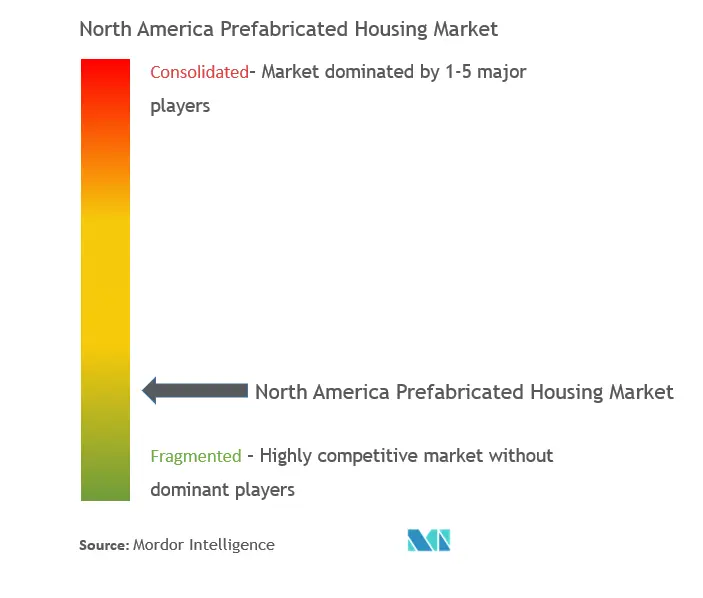
North America Prefabricated Housing Market News
- April 2022: Clayton Homes, a national builder of both off-site and on-site homes, showed off its first single-section CrossMod home at the Manufactured Housing Institute's Congress & Expo. This gives another group of homebuyers and locations a new affordable housing option.
- January 2022: Volumetric Building Companies (VBC), one of the largest multifamily volumetric modular and components businesses in the United States, announced a merger with Polcom Group (Polcom), a premium steel modular building and custom furniture manufacturing conglomerate for the hospitality market. By combining VBC's innovative wood construction technology with Polcom's advanced steel modular system, the deal will change the way people build things. The Polycom merger comes right after VBC bought the assets of Katerra Inc., which included its offices and state-of-the-art manufacturing facility in Tracy, CA.
North America Prefabricated Housing Market Report - Table of Contents
1. INTRODUCTION
- 1.1 Study Assumptions
- 1.2 Scope of the Study
2. RESEARCH METHODOLOGY
- 2.1 Analysis Methodology
- 2.2 Research Phases
3. EXECUTIVE SUMMARY
4. MARKET INSIGHTS
- 4.1 Current Market Scenario
- 4.2 Technological Trends
- 4.3 Insights on Supply Chain/Value Chain Analysis of the Prefabricated Housing Industry
- 4.4 Cost Structure Analysis of the Prefabricated Housing Industry
- 4.5 Insights on Different Types of Materials used in Prefabricated Housing Construction
- 4.6 Impact of COVID-19 on the Market
5. MARKET DYNAMICS
- 5.1 Drivers
- 5.2 Restraints
- 5.3 Opportunities
-
5.4 Porter's Five Forces Analysis
- 5.4.1 Bargaining Power of Suppliers
- 5.4.2 Bargaining Power of Consumers/Buyers
- 5.4.3 Threat of New Entrants
- 5.4.4 Threat of Substitute Products
- 5.4.5 Intensity of Competitive Rivalry
6. MARKET SEGMENTATION (By Value)
-
6.1 By Type
- 6.1.1 Single-family
- 6.1.2 Multi-family
-
6.2 By Country
- 6.2.1 United States
- 6.2.2 Canada
- 6.2.3 Mexico
7. COMPETITIVE LANDSCAPE
- 7.1 Overview
-
7.2 Company Profiles
- 7.2.1 Skyline Corporation
- 7.2.2 Champion Home Builders Inc.
- 7.2.3 Clayton Homes Inc.
- 7.2.4 Perrin Construction Co. Inc.
- 7.2.5 Ritz-Craft Corporation
- 7.2.6 Cavalier Home Builders LLC
- 7.2.7 Triple M Housing Ltd
- 7.2.8 Nobility Homes Inc.
- 7.2.9 Jacobsen Homes
- 7.2.10 Sunshine Homes Inc.
- 7.2.11 Lindal Cedar Homes*
- *List Not Exhaustive
8. MARKET OPPORTUNITIES AND FUTURE TRENDS
9. APPENDIX
- 9.1 Macroeconomic Indicators (GDP Breakdown by Sector, Contribution of Construction to Economy, Etc.)
- 9.2 Key Production, Consumption, Exports, and Import Statistics of Construction Materials
North America Prefabricated Housing Industry Segmentation
Prefabricated homes, often referred to as "prefab homes," are primarily manufactured off-site and then delivered and assembled on-site.
The North American prefabricated housing market is segmented by type (single-family and multi-family) and country (the United States, Canada, and Mexico). The report offers market size and forecasts for the North American prefabricated housing market in value (USD billion).
| By Type | Single-family |
| Multi-family | |
| By Country | United States |
| Canada | |
| Mexico |
North America Prefabricated Housing Market Research FAQs
How big is the North America Prefabricated Housing Market?
The North America Prefabricated Housing Market size is expected to reach USD 24.97 billion in 2024 and grow at a CAGR of 6.99% to reach USD 35.02 billion by 2029.
What is the current North America Prefabricated Housing Market size?
In 2024, the North America Prefabricated Housing Market size is expected to reach USD 24.97 billion.
Who are the key players in North America Prefabricated Housing Market?
Skyline Corporation, Champion Home Builders Inc., Clayton Homes Inc., Perrin Construction Co. Inc. and Ritz-Craft Corporation are the major companies operating in the North America Prefabricated Housing Market.
What years does this North America Prefabricated Housing Market cover, and what was the market size in 2023?
In 2023, the North America Prefabricated Housing Market size was estimated at USD 23.22 billion. The report covers the North America Prefabricated Housing Market historical market size for years: 2020, 2021, 2022 and 2023. The report also forecasts the North America Prefabricated Housing Market size for years: 2024, 2025, 2026, 2027, 2028 and 2029.
North America Prefabricated House Industry Report
Statistics for the 2023 North America Prefabricated House market share, size and revenue growth rate, created by Mordor Intelligence™ Industry Reports. North America Prefabricated House analysis includes a market forecast outlook to 2029 and historical overview. Get a sample of this industry analysis as a free report PDF download.



